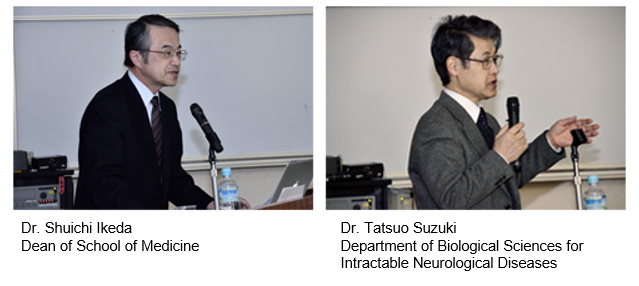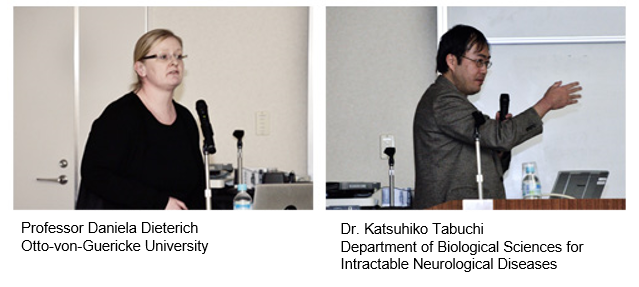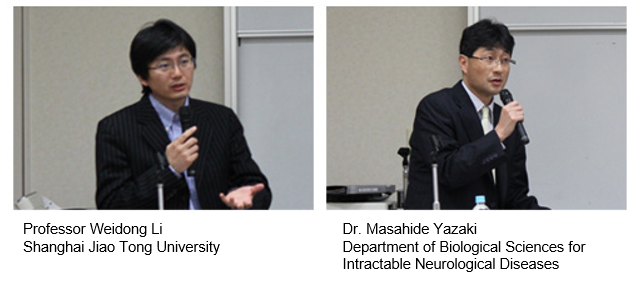The First Institute for Biomedical Sciences International Symposium was held on March 6, 2015, from 13:00 to 16:30; it ended around the scheduled time.
Lectures were delivered by 2 guests, Professor Daniela Dieterich from Germany and Professor Weidong Li from China, and 2 members, Professor Katushiko Tabuchi and Professor Tatsuo Suzuki, from the Institute for Biomedical Sciences. Fifty-one researchers attended the meeting; this included lecturers, 3 external researchers (one of whom belongs to the NIH and is currently at Shinshu University), and 3 guests whose affiliations are unknown.
After the opening remarks by the dean of the Medical School of Shinshu University, Professor Suzuki explained the background of the symposium, which included groundbreaking studies in the field of memory over the past 30 years and significance of synapses in the memory process. He stated that these results of memory studies were expected to facilitate the progress of studies about mental and neurological symptoms. Therefore, this symposium was held to summarize synapse studies to date and share the results to facilitate future neuroscience research. Lectures on molecular-level studies were delivered in the first 2 lectures, followed by 2 lectures on studies with mouse disease models.
In the first lecture, Professor Suzuki discussed studies of molecules that make up synapses, in particular, the identification of postsynaptic density proteins. He then discussed the molecular structure of the postsynaptic density and raft domain of the synapse membrane, which plays an important role together with the postsynaptic density. The second lecture was by Professor Dieterich and detailed her self-developed specific methods for analyzing the local postsynaptic protein synthesis system and applications of the procedure. This was followed by a 15-minute break. The third lecture by Professor Tabuchi analyzed the molecular level pathologies of autism using a mouse model of autism generated by him. He suggested abnormal synapse maturation as a possible cause of autism. In the final lecture, Professor Li reported that he generated multiple schizophrenia-like model mice and analyzed their molecular pathologies. He explained that molecular abnormalities in multiple intracellular signaling pathways underlie the presentation of symptoms. He also introduced the summer school of neuroscience at Jiao-Tong University.
Throughout this symposium, 4 lectures representing major fields in synapse research were delivered. This symposium served as a valuable opportunity for researchers at Shinshu University (especially those from other fields) to understand results from over 30 years synapse research, the present status of such studies, and importance of synapse studies as a topic in basic research. At the closing, Associate Professor Yazaki, the Head of the Department of Biological Sciences for Intractable Neurological Diseases, expressed his desire to facilitate activities of the Institute for Biomedical Sciences by collaborations with foreign researchers, including those invited to the symposium.
Lectures were delivered by 2 guests, Professor Daniela Dieterich from Germany and Professor Weidong Li from China, and 2 members, Professor Katushiko Tabuchi and Professor Tatsuo Suzuki, from the Institute for Biomedical Sciences. Fifty-one researchers attended the meeting; this included lecturers, 3 external researchers (one of whom belongs to the NIH and is currently at Shinshu University), and 3 guests whose affiliations are unknown.
After the opening remarks by the dean of the Medical School of Shinshu University, Professor Suzuki explained the background of the symposium, which included groundbreaking studies in the field of memory over the past 30 years and significance of synapses in the memory process. He stated that these results of memory studies were expected to facilitate the progress of studies about mental and neurological symptoms. Therefore, this symposium was held to summarize synapse studies to date and share the results to facilitate future neuroscience research. Lectures on molecular-level studies were delivered in the first 2 lectures, followed by 2 lectures on studies with mouse disease models.
In the first lecture, Professor Suzuki discussed studies of molecules that make up synapses, in particular, the identification of postsynaptic density proteins. He then discussed the molecular structure of the postsynaptic density and raft domain of the synapse membrane, which plays an important role together with the postsynaptic density. The second lecture was by Professor Dieterich and detailed her self-developed specific methods for analyzing the local postsynaptic protein synthesis system and applications of the procedure. This was followed by a 15-minute break. The third lecture by Professor Tabuchi analyzed the molecular level pathologies of autism using a mouse model of autism generated by him. He suggested abnormal synapse maturation as a possible cause of autism. In the final lecture, Professor Li reported that he generated multiple schizophrenia-like model mice and analyzed their molecular pathologies. He explained that molecular abnormalities in multiple intracellular signaling pathways underlie the presentation of symptoms. He also introduced the summer school of neuroscience at Jiao-Tong University.
Throughout this symposium, 4 lectures representing major fields in synapse research were delivered. This symposium served as a valuable opportunity for researchers at Shinshu University (especially those from other fields) to understand results from over 30 years synapse research, the present status of such studies, and importance of synapse studies as a topic in basic research. At the closing, Associate Professor Yazaki, the Head of the Department of Biological Sciences for Intractable Neurological Diseases, expressed his desire to facilitate activities of the Institute for Biomedical Sciences by collaborations with foreign researchers, including those invited to the symposium.




